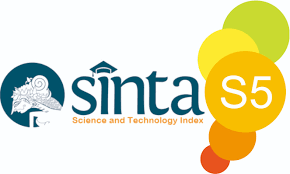SELEKSI FITUR DAN OPTIMASI PARAMETER k-NN BERBASIS ALGORITMA GENETIKA PADA DATASET MEDIS
DOI:
https://doi.org/10.51977/jti.v2i2.319Keywords:
klasifikasi, algoritma genetika, fitur seleksi, optimasi parameter, k-nearest neighborAbstract
Klasifikasi dataset medis adalah masalah data mining utama yang sedang diteliti selama satu dekade yang telah menarik beberapa peneliti dari berbagai bidang. Banyak algoritma klasifikasi dirancang untuk belajar dari data itu sendiri melalui proses pelatihan, karena pengetahuan ahli untuk menentukan parameter klasifikasi sulit. Penelitian ini mengusulkan metodologi yang didasarkan pada paradigma data mining. Paradigma ini mengintegrasikan pencarian heuristic yang terinspirasi dari evolusi alam yang disebut algoritma genetika dengan algoritma pembelajaran yang paling sederhana dan paling banyak digunakan, k nearest neighbor. Algoritma genetika digunakan untuk pemilihan fitur dan optimasi parameter sedangkan k-nearest neighbor digunakan sebagai algoritma klasifikasi. Metode yang diusulkan diujicobakan pada lima dataset medis dari UCI Machine Learning Repository untuk menangani klasifikasi dataset medis. Hasil percobaan menunjukkan bahwa metode yang diusulkan mampu mencapai kinerja yang baik, dibandingkan dengan hasil pengklasifikasi lain dengan peningkatan yang signifikan dengan nilai p uji-t 0.0011.
References
Afandi, Pandy (2016). Concept & Indicator Human Resources Management for Management Research. Deepublish CV Budi Utama: Yogyakarta.
Amalia, Rizca., Adman. (2017). Pengaruh insentif terhadap disiplin kerja pegawai dinas tenaga kerja kabupaten bandung. Jurnal Manajemen,173-186.
Asmira (2016). Jurnal Efektivitas penerapan absensi (fingerprint) dalam meningkatkan disiplin. Jurnal Pemerintahan, Volume 4, Nomor 3, 1009-1022.
Fathoni, Abdurrahmat. (2014). Organisasi & manajemen sumber daya manusia. Jakarta: PT.Rineka Cipta.
Mangkunegara, Anwar Prabu. (2015). Manajemen sumber daya manusia perusahaan. Bandung: PT.Remaja Rosdakarya.
Mayangsari, Diana, (2013). “ Pengaruh Pemberian Insentif Terhadap Kinerja Karyawan ( Studi Pada AJB BUMI PETERA 1921 Kantor Cabang Kayutangan, Malang)’. Skripsi Diakses September 2012
Mushlikhun, Hasiolan, L. B., & Fathoni, A. (2016). Pengaruh Mekanisme Finger Print, Prosedur Finger Print. Journal of Managemen
Setiawan, Dodi., & Yulianti. (2017). Absensi fingerprint terhadap disiplin kerja karyawan pada pt. sanbio laboratories gunung putri kabupaten bogor. Jurnal Majalah Ilmiah Institut STIAMI, Volume 14, No. 01, 70-81.
Sina, Muhammad Gazali. 2016. Efektivitas Pemasangan Absen Sidik Jari (Finger Scan) Dalam Meningkatkan Disiplin Kerja Pegawai Rektorat Universitas Mulawarman Samarinda Ejournal Ilmu Pemerintahan 2016, 4 (1): 215-229
Sutrisno, Edy (2009). Manajemen Sumber Daya Manusia. Kencana:Jakarta.
Universitas Pendidikan Indonesia (2017). Insentif berbasis kinerja bagi dosen dan tenaga kependidikan di lingkungan universitas pendidikan indonesia. Bandung.
Downloads
Published
Issue
Section
License
Pemberitahuan Hak Cipta
Usulan kebijakan untuk jurnal yang menawarkan akses terbuka Syarat yang dibutuhkan penulis adalah sebagai berikut:
1. Penulis memegang hak cipta dan memberikan jurnal hak penerbitan pertama secara bersamaan di bawah lisensi di bawah Creative Commons Attribution-ShareAlike 4.0 International (CC BY-SA 4.0), yang mengizinkan orang lain untuk menyalin dan mendistribusikan ulang materi ini dalam bentuk atau format apa pun termasuk menyusun, memodifikasi, dan membuat turunan materi ini untuk tujuan apa pun, termasuk tujuan komersial.
2. Penulis dapat membuat pengaturan kontrak terpisah untuk distribusi non-eksklusif dari versi dekaden publikasi jurnal (misalnya mempostingnya ke repositori institusional atau menerbitkannya dalam sebuah buku), dengan mengakui publikasi aslinya di jurnal ini.
3. Penulis diizinkan dan didorong untuk memposting artikel secara online (misalnya di repositori institusional atau di situs web mereka) seperti pada Garuda, Academia, researchgate atau repository lainnya sebelum dan selama proses pengiriman, karena dapat menghasilkan pertukaran yang produktif dan kutipan artikel yang diterbitkan lebih awal dan lebih maju (periksa: Efek Akses Terbuka)

This work is licensed under a Creative Commons Attribution-ShareAlike 4.0 International License.











